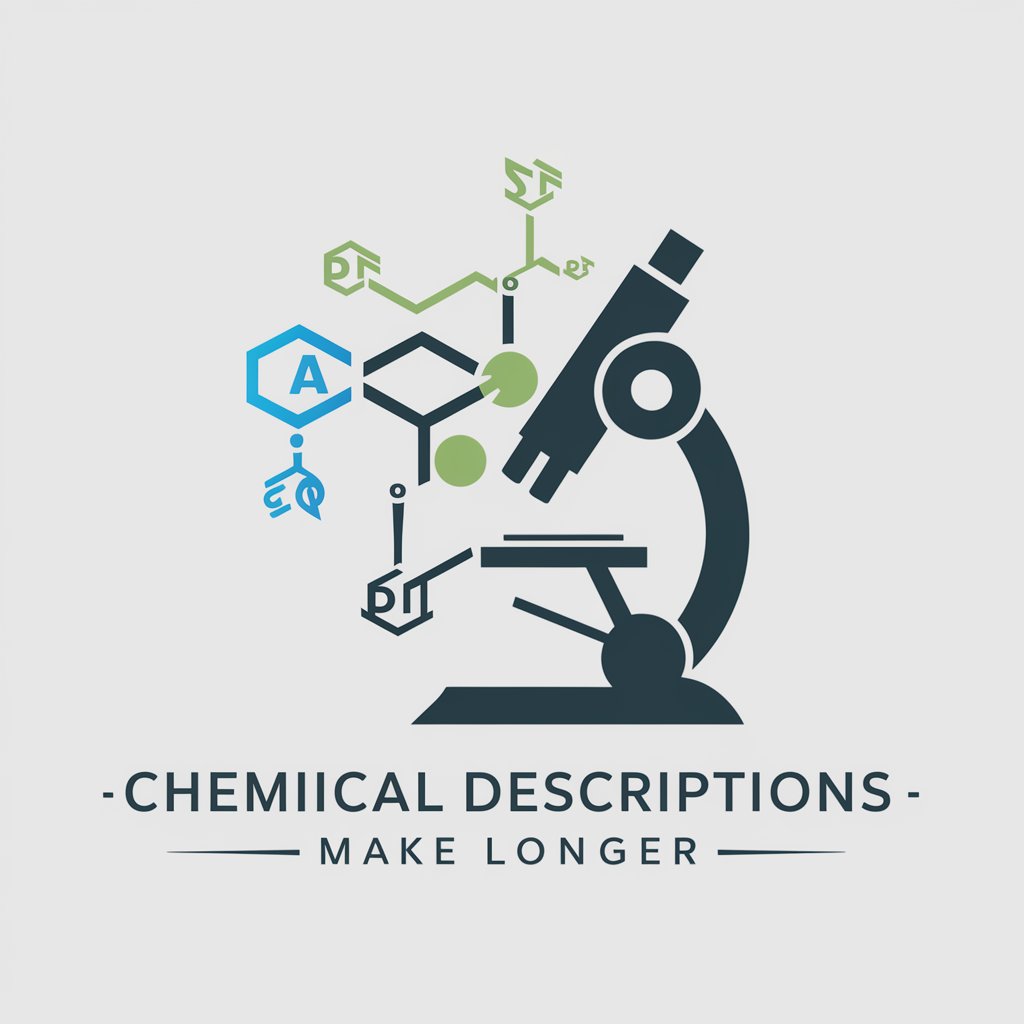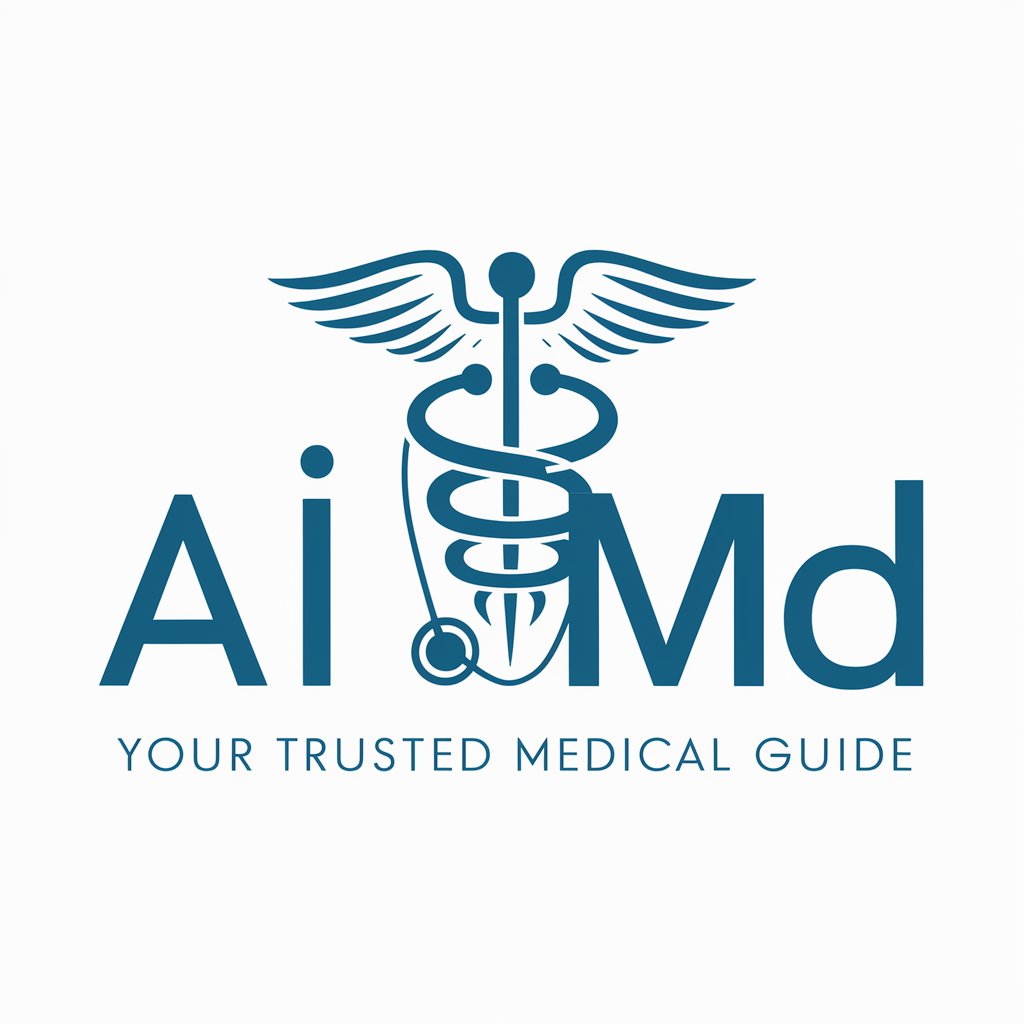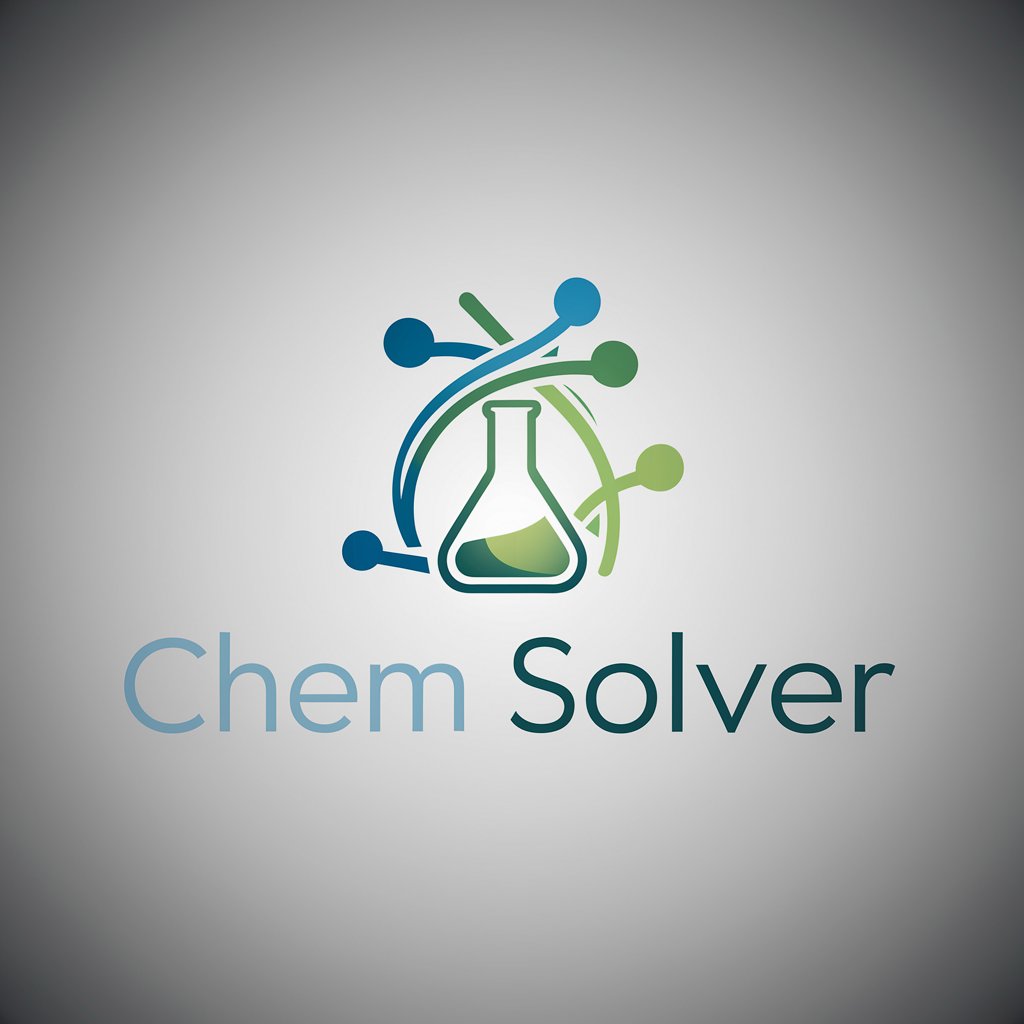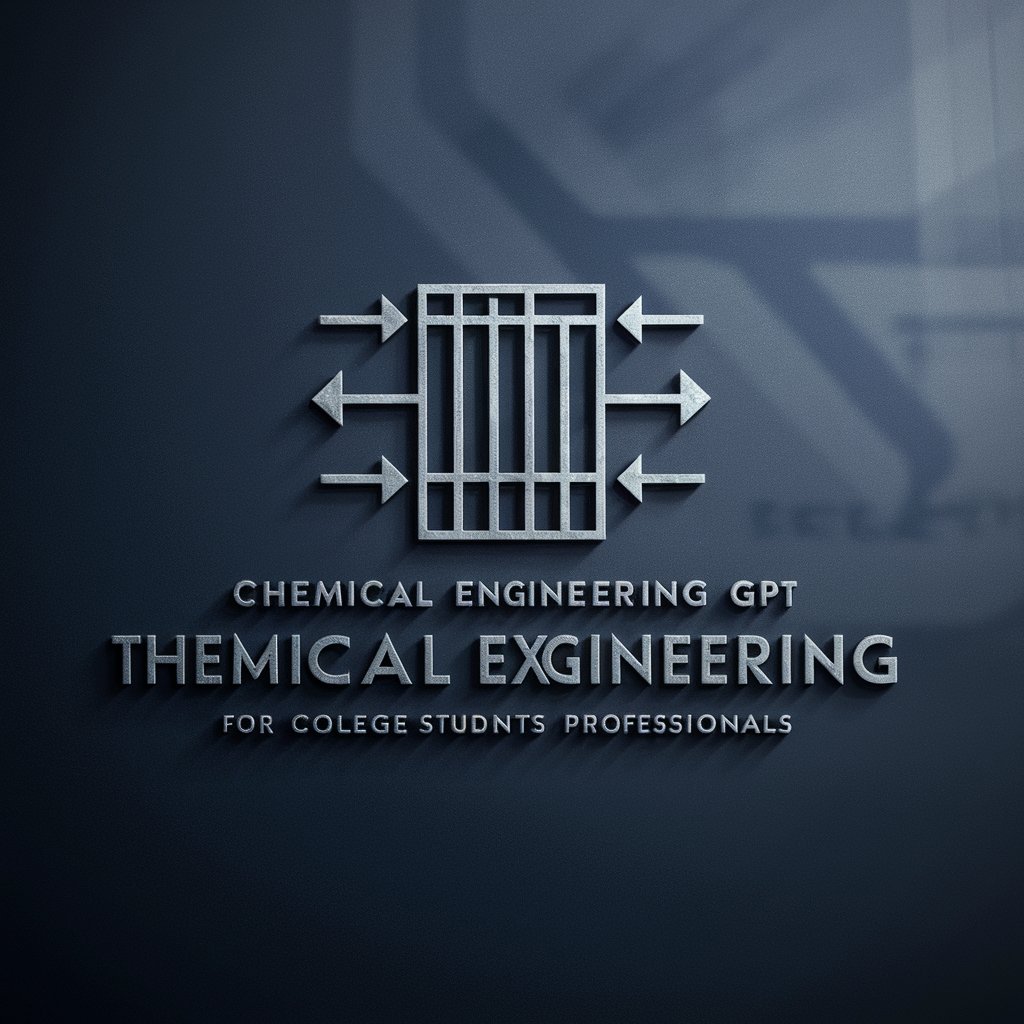
Chemical descriptions - make longer-AI tool for expanding chemical descriptions.
AI-powered tool for detailed chemical descriptions.

enhances the description
copy & paste the current description
Get Embed Code
Introduction to Chemical Descriptions
Chemical descriptions refer to the systematic method of detailing the properties, structures, and behaviors of chemicals. This can include their molecular composition, physical and chemical properties, reactivity, and interactions with other substances. Chemical descriptions serve as a critical framework for understanding how chemicals behave in different environments, which is essential for fields ranging from pharmaceuticals to environmental science. The basic function of a chemical description is to provide clarity and consistency when communicating about chemical substances, ensuring that researchers, scientists, engineers, and industry professionals have accurate and reliable data to work with. These descriptions are designed to communicate not only the chemical structure but also the practical applications and potential hazards associated with a substance. For example, the chemical description of water (H₂O) includes information on its molecular structure, its boiling and freezing points, its behavior as a solvent, and its role in supporting life. This data allows chemists to predict how water will interact with other substances in various chemical reactions or in industrial applications. Similarly, descriptions of more complex compounds, like pharmaceuticals, will include details about their molecular pathways in the body, theirChemical descriptions overview solubility, stability, and dosage forms. Thus, chemical descriptions are foundational in ensuring consistency and safety across all industries that deal with chemicals.
Main Functions of Chemical Descriptions
Molecular Identification and Structure Representation
Example
The description of methane (CH₄), the simplest hydrocarbon, includes details about its tetrahedral molecular structure, with carbon at the center bonded to four hydrogen atoms. This molecular formula is essential in distinguishing methane from other hydrocarbons, such as ethane (C₂H₆).
Scenario
In a chemical laboratory, a researcher synthesizes methane for a specific experiment. A detailed chemical description of methane, including its bonding and molecular geometry, helps predict how it will behave under specific conditions (e.g., its flammability or reactivity with other gases like oxygen).
Predicting Chemical Behavior and Reactivity
Example
A description of sulfuric acid (H₂SO₄) includes information about its strong acidic nature, its corrosive properties, and how it reacts with metals like zinc to release hydrogen gas.
Scenario
In industrial settings, sulfuric acid is used in the production of fertilizers. A detailed chemical description informs engineers on how to safely store and handle the substance, avoiding dangerous reactions. For instance, the reactivity with water must be carefully controlled to prevent violent exothermic reactions.
Facilitating Communication Across Disciplines
Example
The description of acetone (C₃H₆O) might include its role as a solvent in various chemical processes, its polarity, and its ability to dissolve both polar and non-polar substances.
Scenario
In a pharmaceutical company, acetone is used to extract specific compounds from plant material. The chemical description helps the lab technicians and chemists understand acetone's solubility and volatility, aiding in designing an efficient and safe extraction process. It also helps in communicating how acetone may interact with other chemicals or be affected by environmental conditions like temperature.
Ideal Users of Chemical Descriptions
Chemists and Researchers
Chemists and researchers across fields such as organic chemistry, biochemistry, and materials science are primary users of detailed chemical descriptions. They rely on these descriptions to design experiments, synthesize new compounds, and analyze the behavior of substances. Accurate chemical descriptions enable researchers to predict molecular interactions, optimize chemical processes, and improve the safety and efficiency of experiments. For instance, a chemist researching new pharmaceuticals would need to thoroughly understand the chemical properties of the drug under study, including its solubility, reactivity, and stability.
Chemical Engineers
Chemical engineers are responsible for scaling up chemical processes from the laboratory to industrial levels. They depend heavily on detailed chemical descriptions to design systems that safely and efficiently process raw materials into finished products. Whether working in petrochemical plants, water treatment facilities, or food production, understanding the chemical properties of materials allows engineers to optimize processes, troubleshoot issues, and prevent accidents. For example, an engineer working in the food industry might need to know the chemical composition of preservatives to ensure they work effectively without compromising the safety of the product.
Regulatory Agencies and Safety Inspectors
Government bodies such as the Environmental Protection Agency (EPA) or Occupational Safety and Health Administration (OSHA), as well as safety officers in industrial plants, rely on chemical descriptions to assess the safety and environmental impact of chemicals. By understanding the reactivity, toxicity, and stability of chemicals, they can set guidelines for safe usage and disposal, as well as emergency response procedures. For instance, a safety officer would need to understand the detailed chemical description of a chemical like chlorine gas to effectively handle a leak and minimize risk to personnel and the environment.
Pharmaceutical Professionals
Pharmaceutical scientists, pharmacists, and healthcare providers use chemical descriptions to understand the properties of drugs. These descriptions include molecular structure, pharmacokinetics, and potential side effects. Pharmacists, for example, rely on these descriptions to determine how drugs will interact in the body, how they should be dosed, and how they may interact with other medications. In drug development, pharmaceutical professionals also use chemical descriptions to create new drugs with targeted mechanisms of action, as seen with cancer therapies that specifically target cancer cells based on their molecular properties.
How to Use 'Chemical Descriptions - Make Longer'
Visit aichatonline.org for a free trial without loggingJSON code correction in
Access the site directly for a free trial of the tool, no login required, and no need for ChatGPT Plus. This gives you immediate access to explore the functionalities.
Provide initial chemical description input
Once on the platform, input your chemical description or formula. This could be any brief or technical explanation of a chemical process, substance, or compound that you wish to expand on.
Select the desired length or detail level
Specify how detailed or lengthy you want the description to become. Choose options such as 'detailed explanation,' 'extended analysis,' or 'scientifically enriched' to adjust the depth of the output.
Refine and review the generated content
After receiving the expanded description, review it for accuracy and relevance. You can tweak the length further by adjusting your preferences or adding specific instructions for clarity or emphasis.
Download or copy the final description
Once satisfied with the output, either download it in your preferred format or copyJSON code correction the content directly to use in your work, whether for academic, industrial, or personal purposes.
Try other advanced and practical GPTs
PresentationMaker
AI-powered slide creation for polished presentations

很6的公众号改写专家
AI-powered WeChat article rewriting tool

编程专家
AI-powered coding expert for fast development

楽天ROOM商品レビュアー
AI-powered insights to enhance your reviews.

Best Long-Form AI Writing Tool by Alex Kosch
AI-powered long-form content generation tool.

CSV Excel Table Creator
AI-powered tool for instant CSV creation

Perfil do Cliente Ideal
AI-powered ideal-customer profiling for targeted growth.

短视频脚本大师
AI-powered scriptwriting for short videos.

General Use📌
AI-powered assistant that drafts, edits, and clarifies

AI MD
AI-powered content generation and refinement.

DevOps Guru
AI-powered insights for smarter DevOps management.

Best GPT SEO Copywriter by Max v.1.0
AI-powered SEO copywriting that converts

- Academic Writing
- Product Development
- Scientific Research
- Chemical Engineering
- Environmental Science
Frequently Asked Questions about 'Chemical Descriptions - Make Longer'
How do I input a chemical description for enhancement?
You simply need to type or paste a short chemical description into the tool's text box. The tool will then use AI to expand it into a more detailed and comprehensive explanation based on the parameters you set.
What kinds of descriptions can be enhanced?
You can enhance any type of chemical description, such as the properties of chemicals, reactions, processes, or scientific mechanisms. It's useful for making technical descriptions more accessible or for deepening the scientific content for academic or professional use.
Is there any limit to how long the description can be made?
There is no strict upper limit, but the tool allows you to adjust the length by choosing from predefined options like 'standard,' 'detailed,' or 'in-depth.' You can also refine the content further for greater specificity.
Can the tool provide references or sources for enhanced descriptions?
While the tool primarily focuses on expanding content, it does not generate citations automatically. However, it can enrich your descriptions with context, explanations, and relevant scientific terms, which you can then cross-check or supplement with sources.
How can I ensure the descriptions are scientifically accurate?
To ensure accuracy, it's best to input precise chemical terms and, if possible, brief descriptions that guide the AI towards the correct focus. You can refine the output by indicating key concepts or areas of emphasis to ensure scientific integrity.






